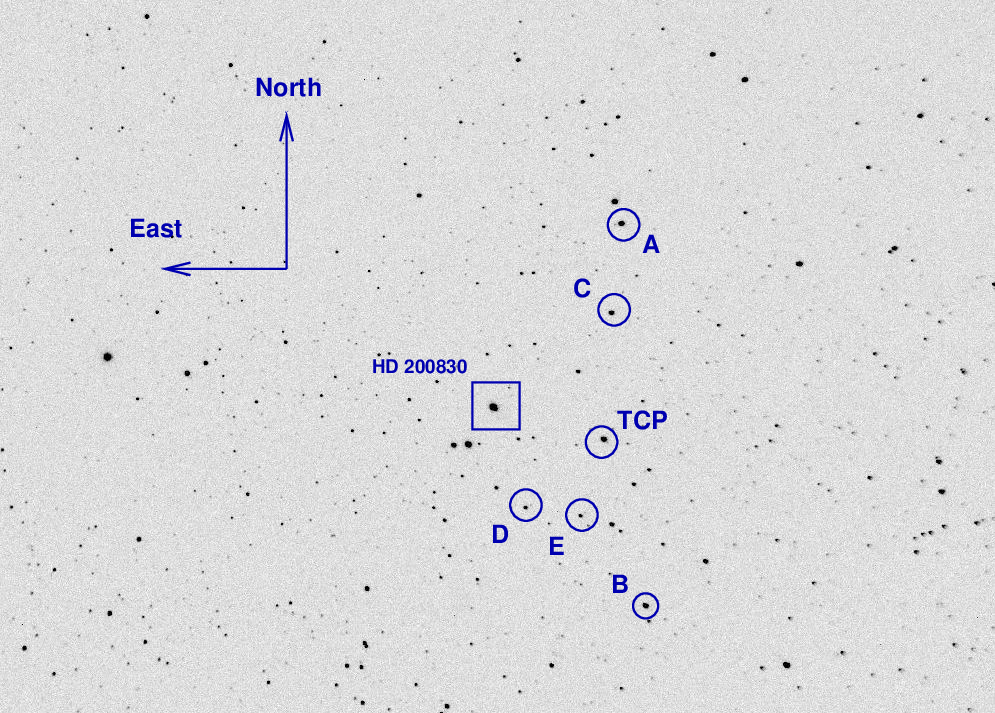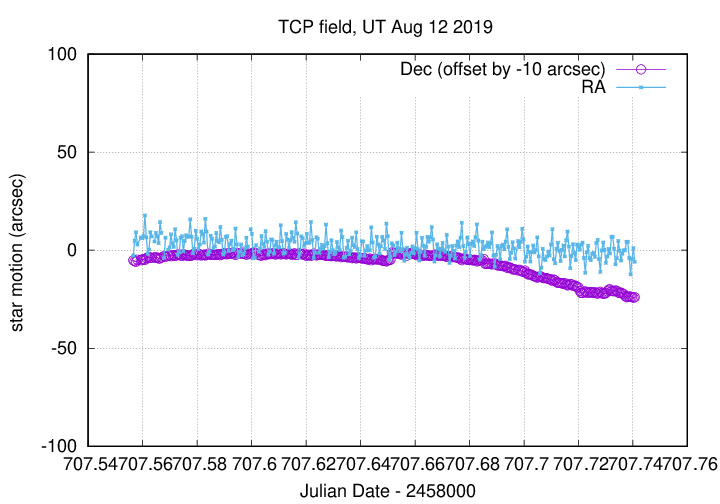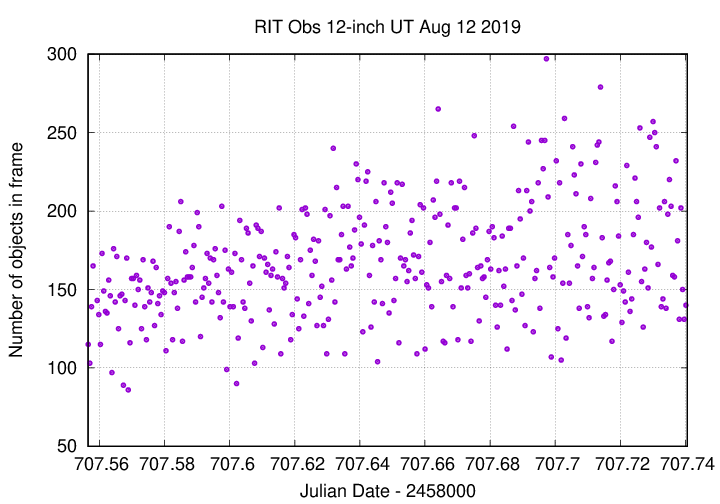
On the night of Aug 11/12, 2019, I acquired a set of observations of the newly discovered WV Sge cataclysmic variable star TCP J21040470+4631129 (see also Astronomer's Telegram 12947 ).
The star remained at the bottom of one of its "dips", with a mean magnitude of V = 14.05 and amplitude of variation of only about 0.05 mag.
The main setup was:
Notes from the night:
The object is located at
RA = 21:04:04.7 Dec = +46:31:12.9
A chart of the field is shown below. The size of the chart is about 21 by 15 arcminutes.

I've marked the location of several comparison stars, which also appear in light curves below.
star UCAC4 B V ---------------------------------------------------- A 683-095755 10.832 10.528 B 683-095722 11.142 10.948 C 683-095772 12.342 10.960 D 683-095866 12.814 12.414 E 683-095811 14.017 12.691 ----------------------------------------------------
When the telescope is pointed at the field, the finder scope's image on the television screen looks like this (North up, East left):

The dark current was a bit higher than usual, due to the higher-than-usual T = -17 C.

The sky value shows no evidence for clouds.

Here's a record of the telescope's drift. The RA drift-and-correct has a very regular pattern. Overall, the guide star remained centered and required no attention or manual adjustments (good), but a number of the 30-second images did show slight trailing East-West.

The number of objects detected.

Note the large scatter in FWHM due to trailing. I used an aperture with radius 4.0 pixels.

I left most images in the ensemble.

Using aperture photometry with a radius of 4 pixels (binned 2x2, each pixel is 1.34 arcsec, so a radius of 5.4 arcsec), I measured the instrumental magnitudes of a number of reference stars and the target. Following the procedures outlined by Kent Honeycutt's article on inhomogeneous ensemble photometry, I used all stars in a 600x600 pixel box around the target in each image to define a reference frame, and measured each star against this frame.
I marked the brightest three stars in the ensemble as "variable," due to saturation. Sigma-vs-mag plots show that the floor was about 0.010 mag originally, which was considerably larger than other nights on this object. When I marked star "A" as variable, the floor dropped to 0.006 mag. I don't think star "A" was saturated, so this is a bit of a mystery.

Here are light curves of the variable and the field stars.

In a change from previous nights, I could not use star "A" = UCAC4 683-095755 as a photometric reference; the overall scatter in photometric solution was larger if I included it in the solution (0.010 mag) than if I marked it as variable (0.006 mag). So, I used the UCAC value for the V-band magnitude of star "B" = UCAC4 683-095722 to shift the ensemble magnitudes to the standard V-band scale.
Here's a closeup of the variable and stars of similar magnitude.

You can download my measurements below. A copy of the header of the file is shown to explain the format.
# Measurements of TCPJ21040470+4631129 made at RIT Obs, UT 2019 Aug 12, # in very good conditions, # by Michael Richmond, # using Meade 12-inch LX200 and ATIK 11000. # Exposures 30 seconds long, V filter. # Tabulated times are midexposure (FITS header time - half exposure length) # and accurate only to +/- 1 second (??). # 'mag' is a differential magnitude based on ensemble photometry # using a circular aperture of radius 4 pix = 5.3 arcseconds. # which has been shifted so UCAC4 683-095722 has mag=10.948 # which is its V-band magnitude according to UCAC4. # # UT_day JD HJD mag uncert Aug12.05655 2458707.55655 2458707.55931 13.974 0.033 Aug12.05705 2458707.55705 2458707.55981 13.978 0.033
Last modified 8/12/2019 by MWR.